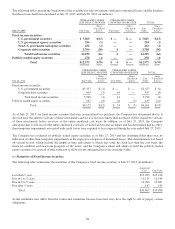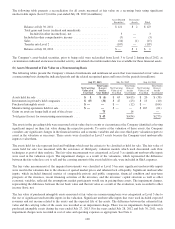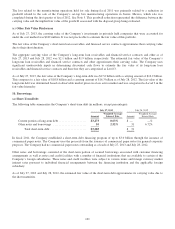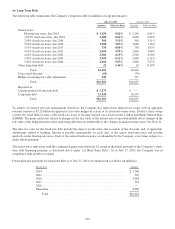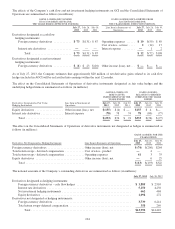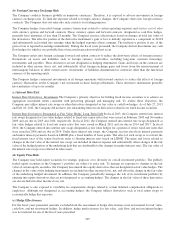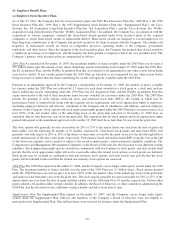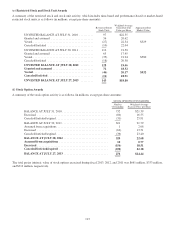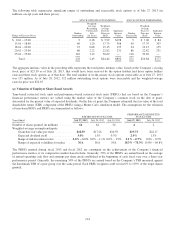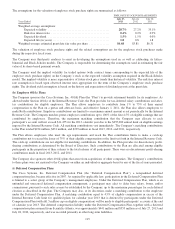Cisco 2013 Annual Report Download - page 116
Download and view the complete annual report
Please find page 116 of the 2013 Cisco annual report below. You can navigate through the pages in the report by either clicking on the pages listed below, or by using the keyword search tool below to find specific information within the annual report.The Company accrues for warranty costs as part of its cost of sales based on associated material product costs, labor costs for
technical support staff, and associated overhead. The Company’s products are generally covered by a warranty for periods
ranging from 90 days to five years, and for some products the Company provides a limited lifetime warranty.
In the normal course of business, the Company indemnifies other parties, including customers, lessors, and parties to other transactions
with the Company, with respect to certain matters. The Company has agreed to hold the other parties harmless against losses arising
from a breach of representations or covenants or out of intellectual property infringement or other claims made against certain parties.
These agreements may limit the time within which an indemnification claim can be made and the amount of the claim. In addition, the
Company has entered into indemnification agreements with its officers and directors, and the Company’s Amended and Restated
Bylaws contain similar indemnification obligations to the Company’s agents. It is not possible to determine the maximum potential
amount under these indemnification agreements due to the Company’s limited history with prior indemnification claims and the unique
facts and circumstances involved in each particular agreement. Historically, payments made by the Company under these agreements
have not had a material effect on the Company’s operating results, financial position, or cash flows.
The Company also provides financing guarantees, which are generally for various third-party financing arrangements to
channel partners and other end-user customers. See Note 7.
The Company’s other guarantee arrangements as of July 27, 2013 and July 28, 2012 that were subject to recognition and
disclosure requirements were not material.
(f) Legal Proceedings
Brazilian authorities have investigated the Company’s Brazilian subsidiary and certain of its current and former employees, as well
as a Brazilian importer of the Company’s products, and its affiliates and employees, relating to alleged evasion of import taxes and
alleged improper transactions involving the subsidiary and the importer. Brazilian tax authorities have assessed claims against the
Company’s Brazilian subsidiary based on a theory of joint liability with the Brazilian importer for import taxes, interest, and
penalties. In addition to claims asserted by the Brazilian federal tax authorities in prior fiscal years, tax authorities from the Brazilian
state of Sao Paulo have asserted similar claims on the same legal basis in prior fiscal years. In the first quarter of fiscal 2013, the
Brazilian federal tax authorities asserted an additional claim against the Company’s Brazilian subsidiary based on a theory of joint
liability with respect to an alleged underpayment of income taxes, social taxes, interest, and penalties by a Brazilian distributor.
The asserted claims by Brazilian federal tax authorities are for calendar years 2003 through 2008, and the asserted claims by
the tax authorities from the state of Sao Paulo are for calendar years 2005 through 2007. The total asserted claims by Brazilian
state and federal tax authorities aggregate to approximately $385 million for the alleged evasion of import and other taxes,
approximately $1.1 billion for interest, and approximately $1.7 billion for various penalties, all determined using an exchange
rate as of July 27, 2013. The Company has completed a thorough review of the matters and believes the asserted claims against
the Company’s Brazilian subsidiary are without merit, and the Company is defending the claims vigorously. While the
Company believes there is no legal basis for the alleged liability, due to the complexities and uncertainty surrounding the
judicial process in Brazil and the nature of the claims asserting joint liability with the importer, the Company is unable to
determine the likelihood of an unfavorable outcome against its Brazilian subsidiary and is unable to reasonably estimate a
range of loss, if any. The Company does not expect a final judicial determination for several years.
On March 31, 2011 and April 12, 2011, purported shareholder class action lawsuits were filed in the United States District Court
for the Northern District of California against the Company and certain of its officers and directors. The lawsuits were
consolidated, and an amended consolidated complaint was filed on December 2, 2011. The consolidated action was purportedly
brought on behalf of purchasers of the Company’s publicly traded securities between February 3, 2010 and May 11, 2011.
Plaintiffs alleged that defendants made false and misleading statements, purported to assert claims for violations of the federal
securities laws, and sought unspecified compensatory damages and other relief. On February 12, 2012, the Company filed a
motion seeking to dismiss all claims in the amended complaint. On March 29, 2013, the Court granted the Company’s motion and
dismissed the amended complaint, finding no facts or inferences to support the plaintiffs’ allegations. Plaintiffs chose not to file
an amended complaint and not to pursue an appeal. The Court dismissed the entire lawsuit with prejudice on April 29, 2013.
Beginning on April 8, 2011, a number of purported shareholder derivative lawsuits were filed in both the United States District Court for
the Northern District of California and the California Superior Court for the County of Santa Clara against the Company’s Board of
Directors and several of its officers. The federal lawsuits have been consolidated in the Northern District of California. Plaintiffs in both
the federal and state derivative actions allege that the Board allowed certain officers to make allegedly false and misleading statements.
The complaint includes claims for violation of the federal securities laws, breach of fiduciary duties, waste of corporate assets, unjust
enrichment, and violations of the California Corporations Code. The complaint seeks compensatory damages, disgorgement, and other
relief. In light of the United States District Court’s dismissal of the purported shareholder class action noted above, the consolidated
federal derivative action was dismissed on May 9, 2013, and the state derivative lawsuits were dismissed on May 16, 2013.
108


